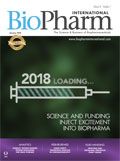Milestones Mark Progress and Challenges
BioPharm International will mark 30 years of biopharma industry progress and challenges in 2018.
The biopharmaceutical industry hit a milestone in 2017 with FDA’s approval of the first gene-therapy drugs, demonstrating the innovative capacity of a research-driven industry. Just two years prior, FDA approved the first biosimilar drugs, illustrating the growing pains for a maturing market when generic drugs join innovator products.
In 2018, BioPharm International will mark 30 years of publishing science and business news for the biopharmaceutical market. Throughout the year, and in a special issue published in July, the editors will note key phases of development in the industry, and the challenges ahead.
Some immediate challenges are outlined in the 2018 Biopharma Outlook in this issue. Following the first year of the Trump administration, people have learned to expect the unexpected. The confirmation of Scott Gottlieb as FDA commissioner provided some stability for the agency, as did renewal of the user fee programs. The slashing of corporate taxes at the end of 2017 promised more financial options for bio/pharma companies. However, uncertainties surrounding the healthcare reform and funding for Medicaid and children’s health programs lingered as 2018 began.
While such macro events may be beyond the control of most biopharma professionals, those that work in drug development formulation, and manufacturing see daily business operations up close and form opinions about the outlook for 2018.
Outlook from the front line
BioPharm International sampled opinions of biopharma professionals from around the world (1) about trends in the industry and future business prospects. Overall, business activity at respondent companies was stable from 2016 to 2017. Approximately the same number of respondents said business increased compared with the previous year (45.3% in 2107 vs. 46.2% in 2016 (2). However, more respondents (17.5%) said business at their company decreased in 2017 compared with 2016 (14.1%).
The most significant change was the decline in the number of respondents reporting business expansion, 16.1% in 2017 compared with 21.2% in 2016. Fewer people reported business closures in 2017 (2.9% vs. 4.7% in 2016), but more 2017 respondents (15.3%) reported downsizing compared with 12.7% in 2016.
Respondents were slightly less upbeat about the prospects of business improvements at their companies; 51.8% predicted that their company’s business would improve in 2018, compared to 52.4% predicting improvements for 2017. The percentage predicting business would decline in the next year (17.5%) was somewhat higher than the previous year (12.7%).
Prognosis for the industry
The one-year outlook for the biopharmaceutical industry as a whole was a bit more positive compared with the previous year. More than half (54.7%) of respondents said business would improve for 2018; 51.7% expected improvements in 2017.
For the longer term (five years), respondents were less optimistic than the previous year. Almost two-thirds (64.7%) of respondents to the 2017 survey expected business to improve over five years compared with 68.5% reporting long-term improvement in 2016.
References
1. 2017 BioPharm International Annual Employment Survey.
2. 2016 BioPharm International Annual Employment Survey.
Article Details
BioPharm International
Volume 31, Number 11
January 2018
Page: 5
Citation
When referring to this article, please cite it as R. Peters, “Milestones Mark Progress and Challenges," BioPharm International 31 (1) 2018.

Tokyo University of Science Research Team Explores Improved Delivery of Antisense Oligonucleotides
April 18th 2025Using cholesterol-modified oligonucleotides, the research team aims to improve the delivery of antisense nucleotide-based therapies for treating neurodegenerative diseases and brain cancers.